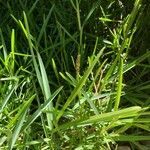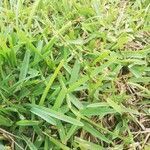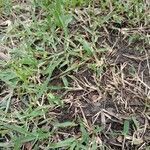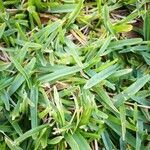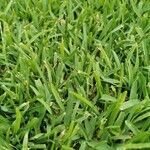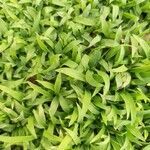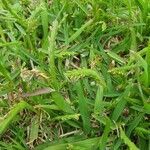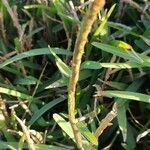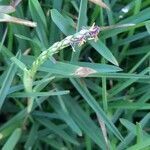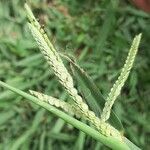Perennial, 60-400 mm high; extensively stoloniferous, forming dense swards; sheaths strongly flattened, often grouped in fan-shaped arrangements; culms rooting at nodes. Leaf blade 50-150 x 4-10 mm long, keeled, apex acute to obtuse or rounded; ligule a fringed membrane. Inflorescence spike-like, compact; central axis thick, swollen, flat on one side, deeply hollowed out on other; each cavity is borne alternately on either side of a wavy, slightly winged midrib, cavity not toothed, each raceme commonly with 1(-3) spikelets. Spikelet 4-5 mm long, dorsiventrally compressed, awnless; glumes very unequal, dissimilar; lower glume 0.8-2.0 mm long, shorter than spikelet, nerveless, obtuse or truncate; upper glume 4-5 mm long, acute or acuminate, 5-7-nerved. Florets 2; lower floret male or sterile, lemma 7-9-nerved, convex or flat on back, palea acute or acuminate; upper floret bisexual, lemma not hardened, 5-nerved; anther 1.8-2.4 mm long. Flowering time Oct.-May.
Perennial 60-400 mm high; extensively stoloniferous, forming dense swards; sheaths strongly flattened, and often grouped in fan-shaped arrangements; culms rooting at the nodes. Leaf blade 50-150 x 4-10 mm long, keeled, apex acute to obtuse or rounded. Inflorescence spike-like, compact; central axis thick, swollen and corky, flat on one side and deeply hollowed out on the other; each cavity is borne alternately on either side of a wavy, slightly winged midrib, ending in a narrow, sharp, naked projection beyond the last spikelet, cavity not toothed, each raceme with 1-3 spikelets. Spikelet 4-5 mm; lower glume 0.8-2.0 mm long, shorter than spikelet, nerveless, obtuse or truncate; upper glume 4-5 mm long, acute or acuminate, 5-7-nerved; lower lemma 4-5 mm long, 7-9-nerved, convex or flat on back; upper lemma not hardened, 5-nerved; lower palea acute or acuminate; anthers 1.8-2.4 mm long.
Perennial, stoloniferous and forming a dense sward. Culms much branched, flowering shoots 10–30 cm tall. Leaf sheaths strongly keeled, often grouped in flabellate clusters; leaf blades broadly linear, folded when young, up to 15 × 0.4–1 cm, apex obtuse; ligule ca. 0.5 mm. Inflorescence 5–12 cm, slender, cylindrical; axis corky, disarticulating into segments at maturity; racemes 4–10 mm, reduced to 1–3 spikelets embedded in one face of the rachis, alternating on either side of the sinuous midrib; raceme rachis a stout pointed appendage within the axis cavity. Spikelets lanceolate, 4–5 mm, acute; lower glume up to 1/4 as long as spikelet; upper glume as long as spikelet; lower floret staminate, lemma cartilaginous, 3-veined, palea well developed; upper lemma papery, subequal to spikelet, smooth, acute. Fl. and fr. summer.
Coarse tough wiry stoloniferous perennial; culms compressed, erect from the usually arching stolons, 5-50 cm. high, long internodes alternate with a series of very short ones, making the leaves in groups; sheaths broad, compressed, keeled, glabrous, sometimes ciliate on the margins, with a small tuft of hairs in the throat; blades flat, conduplicate, obtuse, 2-15 cm. long, as much as 15 mm. wide unfolded, glabrous, the margins scabrous at the tip; racemes terminal on the main culm and short branches from the upper nodes, mostly 4-10 cm. long, straight or curved, the thick rachis 3-4 mm. wide; spikelets 4-6 mm. long, acuminate, glabrous, the first glume obtuse, one-third to half as long as the spikelet.
A grass. It keeps growing from year to year. It has stolons and forms a dense mat. The stems are much branched. The flowering shoots are 10-30 cm tall. The leaf blades are folded when young. They are 15 cm long by 1 cm wide.
Mat-forming, prostrate perennial, sometimes to 30 cm. Leaves oblong, folded. Spikelets partly embedded in a secund, 2-ranked spike, swollen and rounded on one side.
